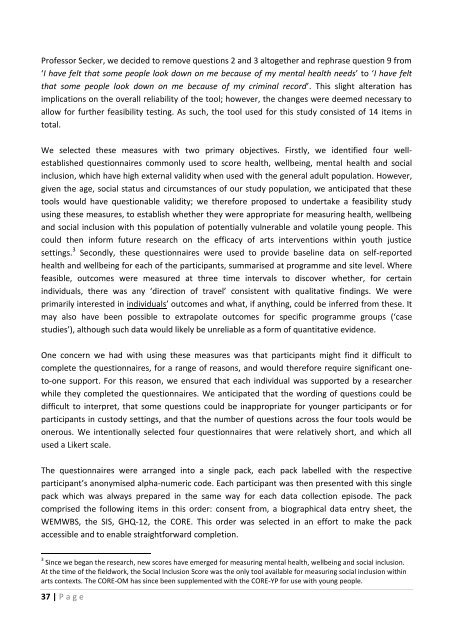De Viggiani, N., Daykin, N., Moriarty, Y. and Pilkington, P. and ...
De Viggiani, N., Daykin, N., Moriarty, Y. and Pilkington, P. and ...
De Viggiani, N., Daykin, N., Moriarty, Y. and Pilkington, P. and ...
You also want an ePaper? Increase the reach of your titles
YUMPU automatically turns print PDFs into web optimized ePapers that Google loves.
Professor Secker, we decided to remove questions 2 <strong>and</strong> 3 altogether <strong>and</strong> rephrase question 9 from<br />
‘I have felt that some people look down on me because of my mental health needs’ to ‘I have felt<br />
that some people look down on me because of my criminal record’. This slight alteration has<br />
implications on the overall reliability of the tool; however, the changes were deemed necessary to<br />
allow for further feasibility testing. As such, the tool used for this study consisted of 14 items in<br />
total.<br />
We selected these measures with two primary objectives. Firstly, we identified four wellestablished<br />
questionnaires commonly used to score health, wellbeing, mental health <strong>and</strong> social<br />
inclusion, which have high external validity when used with the general adult population. However,<br />
given the age, social status <strong>and</strong> circumstances of our study population, we anticipated that these<br />
tools would have questionable validity; we therefore proposed to undertake a feasibility study<br />
using these measures, to establish whether they were appropriate for measuring health, wellbeing<br />
<strong>and</strong> social inclusion with this population of potentially vulnerable <strong>and</strong> volatile young people. This<br />
could then inform future research on the efficacy of arts interventions within youth justice<br />
settings. 3 Secondly, these questionnaires were used to provide baseline data on self-reported<br />
health <strong>and</strong> wellbeing for each of the participants, summarised at programme <strong>and</strong> site level. Where<br />
feasible, outcomes were measured at three time intervals to discover whether, for certain<br />
individuals, there was any ‘direction of travel’ consistent with qualitative findings. We were<br />
primarily interested in individuals’ outcomes <strong>and</strong> what, if anything, could be inferred from these. It<br />
may also have been possible to extrapolate outcomes for specific programme groups (‘case<br />
studies’), although such data would likely be unreliable as a form of quantitative evidence.<br />
One concern we had with using these measures was that participants might find it difficult to<br />
complete the questionnaires, for a range of reasons, <strong>and</strong> would therefore require significant oneto-one<br />
support. For this reason, we ensured that each individual was supported by a researcher<br />
while they completed the questionnaires. We anticipated that the wording of questions could be<br />
difficult to interpret, that some questions could be inappropriate for younger participants or for<br />
participants in custody settings, <strong>and</strong> that the number of questions across the four tools would be<br />
onerous. We intentionally selected four questionnaires that were relatively short, <strong>and</strong> which all<br />
used a Likert scale.<br />
The questionnaires were arranged into a single pack, each pack labelled with the respective<br />
participant’s anonymised alpha-numeric code. Each participant was then presented with this single<br />
pack which was always prepared in the same way for each data collection episode. The pack<br />
comprised the following items in this order: consent from, a biographical data entry sheet, the<br />
WEMWBS, the SIS, GHQ-12, the CORE. This order was selected in an effort to make the pack<br />
accessible <strong>and</strong> to enable straightforward completion.<br />
3 Since we began the research, new scores have emerged for measuring mental health, wellbeing <strong>and</strong> social inclusion.<br />
At the time of the fieldwork, the Social Inclusion Score was the only tool available for measuring social inclusion within<br />
arts contexts. The CORE-OM has since been supplemented with the CORE-YP for use with young people.<br />
37 | P a g e
















